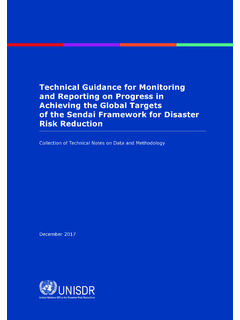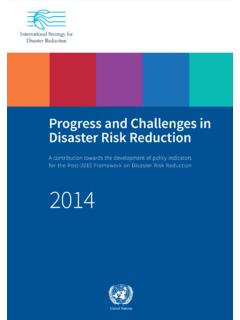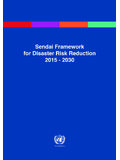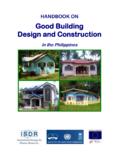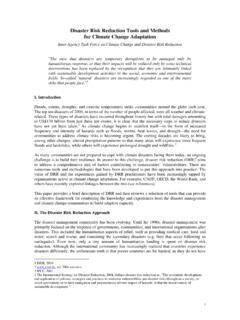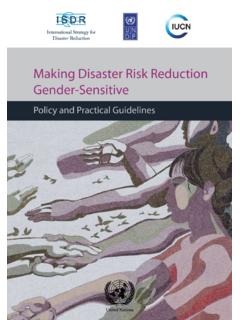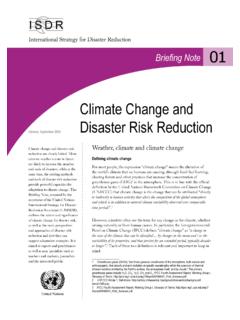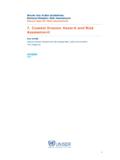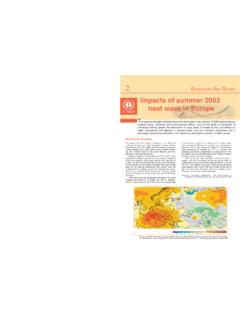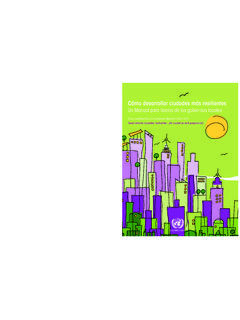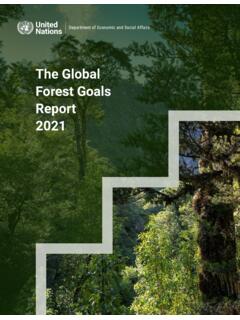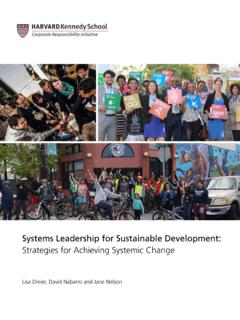Transcription of Disaster Risk Reduction in the Philippines
1 Disaster Risk Reductionin the PhilippinesStatus report 2019 Cover photo: Tappasan Phurisamrit/ Risk Reductionin the PhilippinesStatus report 2019 About this reportThe Disaster Risk Reduction (DRR) report provides a snapshot of the latest DRR progress the Philippines has achieved under the four priorities of the Sendai Framework. It also highlights some of the key challenges surrounding the issue of creating coherence among the key global frameworks at the country level; and makes recommendations for strengthening the overall Disaster Risk Management (DRM) governance by government institutions and other stakeholders at national, sub-national, and local UN Office for Disaster Risk Reduction and the Asian Disaster Preparedness Center acknowledge the governments, international organizations and stakeholder representatives who provided their valuable contribution and feedback to this report .
2 It was made possible by the generous contribution made by the Government of Australia, Department of Foreign Affairs and Trade, as part of the Partnership Framework with the UN Office for Disaster Risk Reduction on Supporting Implementation of the Sendai Framework. The findings, interpretations, and conclusions expressed in this document do not necessarily reflect the views of UNDRR or of the United Nations Secretariat, partners, and governments, and are based on the inputs received during consultative meetings, individual interviews, and the literature reviews conducted by the research team. While every effort has been made to ensure the accuracy of the information, the document remains open for any corrections in facts, figures and publication may be freely quoted but acknowledgement of the source is ( 2019 ).
3 Disaster Risk Reduction in the Philippines : Status report 2019 . Bangkok, Thailand, United Nations Office for Disaster Risk Reduction (UNDRR), Regional Office for Asia and the Pacific Disaster Risk Reduction in the PhilippinesPages // 5(GermanWatch, 2019 )POPULATION 2018 Climate Risk Index Rank 176 / Low Risk*INFORM Risk Index Rank 75 / Medium Risk**Total millionUrban million ( )Population Density Per Km2337 economic INDICATORSG ross Domestic Product in Current $ billionGDP Per Capita ($US) * Climate Risk Index of 2019 analyses the extent to which countries have been affected by weather-related losses between 1998-2017 (GermanWatch, 2019 ). However, it should be noted that the CRI may not provide an accurate presentation of the future risk due to the fact that it measures data of past events (which may not always be available depending on the country).
4 Thus, for example in the case of Philippines , low CRI score does not necessarily indicate low climate risk in the future.** INFORM risk index is a global tool which measures the risk of humanitarian crises and disasters based on 50 indicators assessing hazards, vulnerability and capacity (resources available to mitigate the impact) (INFORM, 2019 )GDP Growth (Annual %) DEVELOPMENTH uman Development Rank113 Income Level CategoryLower-Middle incomeStatus report 2019 Pages // 61. IntroductionPhilippines is an archipelago state, consisting of some 7,100 islands and islets, and covering a land area of approximately 300,000 km2. The country comprises three groups or large islands: (1) the Luzon group in the north and west, consisting of Luzon, Mindoro, and Palawan, (2) the Visaya group in the centre, consisting of Bohol, Cebu, Leyte, Masbate, Negros, Panay and Samar, and (3) Mindanao in the South.
5 Manila and nearby Quezon City, the country s most-populous cities, are part of the National Capital Region (NRC or Metro Manila), located on the largest island Luzon (Cullinane, 2019 ). The islands and groups are divided into four main classes of administrative divisions, which consist of 17 autonomous regions, 81 provinces, 1,489 municipalities, and the smallest political units, 42,044 Barangays as of 2018 (PSA, 2018).The Philippines is governed by a presidential form, in which power is divided among three juridical branches; executive, legislative and judicial, which seek democracy and balance by carrying their equally weighted duties to uphold law, rights and representation of the interests of the people (GoP, 2019 ).
6 In terms of Disaster risk, Philippines ranked third among all of the countries with the highest risks worldwide according to the World Risk report 2018, with index value of (World economic Forum, 2018). At least 60% of the country s total land area is exposed to multiple hazards, and 74% of the population is susceptible to their impact (GFDRR, 2017). This is largely due to the location and geographical context as the risk involving coastal hazards such as typhoons, storm surges and rising sea levels is high. Also, as the islands are located within the Ring of Fire between the Eurasian and Pacific tectonic plates, earthquakes and volcanoes are posing serious risks to the safety of the populace. Flooding, landslides, droughts and tsunamis further contribute to the exposure to natural hazards (CFE-DM, 2018).
7 Of these, hydro-meteorological events including typhoons and floods, accounted for over 80% of the natural disasters in the country during the last half-century (Jha, 2018).Given the local ecologies, agriculture, mining, forestry, fishing and services are major sources of people s livelihoods. In 2019 , employment rate was reported at % (PSA, 2019 ), and out of the three key sectors of employment (industry, agriculture and services), workers in service providing comprised the largest proportion of the employed population (PSA, 2018) (figure 2). Demographic CharacteristicsThe Philippines population has reached more than 100 million, according to the 2015 Population Census (PSA, 2015). 57% of the population resided in Luzon, 23% in the Visayas, and 20% in Mindanao, and in total, of the overall population lived in urban regions (PSA B, 2019 ).
8 The population density in the urban regions is 60 times higher (20 785 persons/km2) than the national average of 337 according to the 2015 census (figure 1).A number of ethnic groups and cultures are found throughout the islands. indigenous peoples constitute approximately 10 15% of the total population of the Philippines and are present in 65 of the country s 78 provinces (Cari o, 2012). The dominant ethnic groups include the Tagalog (28%), Cebuano (13%), Ilocano (9%), Bisaya ( ), Ilonggo Disaster Risk Reduction in the PhilippinesPages // 7( ), and Bikol (6)% (PSA, 2010), along with numerous other minorities and indigenous peoples who inhabit the islands across the archipelago. The majority of indigenous peoples (61%) are found in Mindanao, 33% are found in Luzon, and 6% in the Visayas (National Commission on indigenous Peoples, referenced in Cari o, 2012).
9 Figure 1. Population density in the Philippines (National economic and Development Authority, 2017),Figure 2. Largest industries contributing to, and their portion of the GDP in % in 2018. Data sourced from Philippines Statistical Authority report 2019 Pages // economic Impact of Disasters Since 1990, the Philippines has been affected by 565 Disaster events which have caused an estimated $US 23 billion in damages (Jha, 2018). Approximately of the sources of the country s production have been reported to be susceptible to disasters, and of the total land area is considered to be economically at risk (ADB, 2012). Much of the damage has been resulting from recurrent, massive-scale super typhoons, including Ondoy and Pepeng in 2009, Washi in 2011, Bopha in 2012, Haiyan in 2013, Koppu in 2015, Haima in 2016, and Mangkhut in 2018.
10 Much of the country s exports and trade income have relied on resource-extractive industry (Martinico-Perez, et al., 2018), which further create implications in terms of Disaster vulnerability and sustainable economic and recurrent disasters have had long-term implications on the country s economy (figure 3). The estimated multi-hazard annual losses are close to US$ 8 million, which is equivalent to 69% of the country s social expenditure (Alcayna, et al., 2016). One of the most severe disasters to directly hit the Philippines in the recent history is the typhoon Haiyan in 2013. It affected an estimated 16 million people, destroyed more than million houses and affected hundreds of thousands of hectares of crops across 41 provinces (FAO, 2018).
